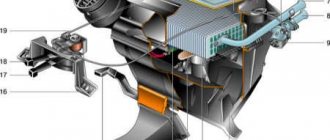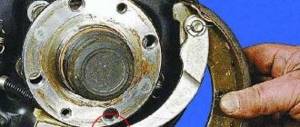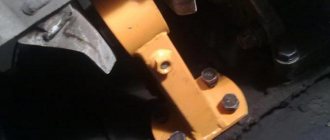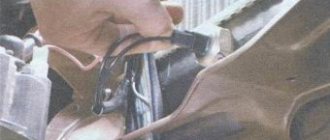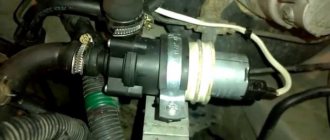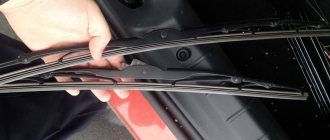There would be no question of any comfort while traveling in a VAZ-21099 car if the interior of this sedan were not equipped with a heating system. Moreover, ensuring a comfortable temperature in the cabin can be considered a secondary task, and the main one is heating the glass (windshield and side front doors) to ensure visibility in conditions of reduced temperatures.
The VAZ-21099 uses a heating system that is classic for all cars, in which the air is heated using an additional radiator of the cooling system installed in the cabin under the dashboard. Thanks to this location, it is possible to provide heating for several zones - airflow onto the windshields and side windows, under the feet and directly into the cabin itself. To ensure the efficiency of the stove, it is necessary that the flow movement is not spontaneous (due to temperature changes), but forced. And for this purpose, the heating system is additionally equipped with an electric fan.
Design of the VAZ-21099 heater
And then everything is simple: the created flow passes through the radiator honeycombs, where heat exchange occurs, as a result, heat is transferred to the air, which then blows into the required zones through the air ducts.
The design of the VAZ-21099 stove includes several main components:
- stove body made of plastic;
- heating system radiator (connected to the cooling system);
- electric fan;
- air ducts;
- heater control mechanism.
This car used heaters of two modifications (old and new), which were slightly different in design, but their components were completely identical.
Housing, radiator, dampers
Thanks to the housing, the required redirection of heating is ensured, since the movement created by the fan motor is immediately fed into it, rather than being dissipated. The body of the VAZ 2109 stove itself consists of two halves, connected to each other with special brackets. To reduce flow losses, a seal is placed between its halves. Partitions are made inside both halves, which provide the correct direction.
There is also a niche inside this case into which the radiator is installed. Initially, the radiator was made of brass, but now it is almost always made of aluminum. The design of the stove radiator 2109 is identical to the main one (consists of two tanks, tubes through which coolant circulates, and plates that form honeycombs), but is significantly smaller in size.
Video: The stove in the VAZ 2108, 2109, 21099, 2110, 2111, 2112, 2113, 2114, 2115 HEATS poorly
Air is blown through the stove dampers, also installed inside the housing. These elements are movable, and thanks to them it is possible to close some and open other air ducts. There are three of them in total - the main one (heater control), an air duct that redirects between the foot area and the supply to the cabin, and a damper for supplying flow to the windshield.
Additional flaps are installed on the side and central deflectors. It turns out that by default, air from the housing constantly blows onto the deflectors and this is done so that the flow always has an exit. Thanks to the existing dampers, it is possible to provide simultaneous supply of hot air to several zones at once (the interior and the windshield or the windshield and the footwell area).
The main heater damper provides air flow to the radiator or bypasses it. This is all done because the heater also plays the role of a forced ventilation system for the interior. This allows for a supply of cool air in the summer. And to do this, you just need to redirect the movement bypassing the heat exchanger, and the supply of heated coolant to the radiator itself will stop. To disconnect the heat exchanger from the cooling system, a heater tap is used, which is located on the supply pipe in front of the radiator.
Fan
The air flow is created by a squirrel wheel fan driven by an electric motor. These two elements are enclosed in their own separate housing, installed on top of the heater housing. Moreover, it is structurally designed to provide the easiest possible access to the electric motor, since it is considered one of the weakest components of the system.
The design provides three modes of fan operation. This allows you to select optimal air supply conditions (cold or hot).
Control mechanism
Video: Useful tips for cars. Why does the VAZ stove not work?
To control the stove and redirect air movement and open and close the coolant supply valve, a control mechanism located on the center console is used. It consists of a three slider mechanism and a fan operating mode switch.
The lower slider is the main one, since it changes the system mode (heating or ventilation). It controls two elements at once - the main damper and the tap. When this slider is switched to the “ventilation” mode, the tap and damper are simultaneously closed, which ensures air movement bypassing the heat exchanger. And everything is exactly the opposite - when you switch it to the “heating” mode.
Replacing the Radiator Heater VAZ 2108 Low Panel
If during a routine inspection of a tank with coolant VAZ 2108 2109 21099 you saw that it became smaller, increased to its usual level, and after a few days the level dropped again. This means that there are some leaks in the cooling system. It is sought through a visual inspection: the attachment points of the hoses, clamps, and the absence of cracks in the hoses are checked. If during the inspection you find that coolant is entering the passenger compartment, this indicates that VAZ 2108 2109 21099 is leaking from the heater radiator. With this malfunction, you begin to drip antifreeze onto the accelerator pedal and connect with it on the driver’s shoes. Antifreeze. corrosive liquid, so you can ruin good shoes. In addition, the antifreeze itself costs money; a liter tube of antifreeze costs about 5. Therefore, since antifreeze begins to leak from the radiators of the VAZ 2109, you need to look for this leak and fix it. What do you need: a replacement heating radiator (stove) for a VAZ 2109 . But it is not easy to approach him. Our client is still in control of the vehicle, saying he needs to disassemble the entire front panel. Of course, without this it will be even more convenient to change the radiator, but it will take you about 3 hours, we are not talking about reassembly. Therefore, the method for replacing the VAZ 2108 2109 21099 heater radiator without removing the front panel is given below. But first you need to drain all the antifreeze from the engine cooling system. Only a VAZ 2109 filled into the cooling system circulates about 8 liters. antifreeze, so prepare tanks where you will pour it in advance. Wear rubber gloves because it is best not to touch antifreeze with bare hands. It will also be useful to have a couple of liters. , because perhaps a little, however, it will shed. Open the coolant reservoir cap and find the cap at the bottom of the radiator.
READ How many lights are there in the dashboard of VAZ 2110
VAZ 2109, radiator drain plug
Prepare a hose about a meter long and a centimeter across. Insert one end into antifreeze. Remove the radiator cap and push the 2 ends of the hose to the radiator outlet. In a VAZ 2108 2109, the radiator 21099 usually holds about 2 liters. antifreeze. When the antifreeze does not leak out, unscrew the plug. Now you need to drain the antifreeze from the small cooling circuit. The engine has a special limiter for discharging antifreeze. This is the vehicle's lowest cooling point.
Drain plug VAZ 2109 for the cooling system
Prepare several plastic bottles (preferably 5 liters), cut off their necks to make it easier to drain the antifreeze. Open the heater mixer in the cab (closed in the picture) to allow all the antifreeze to flow out of the radiator.
Open the VAZ 2109 heated radiator mixer
Unscrew the plug with a 17 key and again press the hose to the drain hole in the engine. Waiting for all the antifreeze to come into contact with the small cooling circuit. Then insert the plug into the area.
Now you need to remove and loosen the clamps on the heater radiator. Unless, of course, you are a very thin person, remove the passenger seat. There will be more than just maneuvers. If you don't want to take photos, move them as far back as possible. We rise to the place where the heater radiator is attached to the hoses of the heating metering system.
READ Replacement Tablet Generator VAZ 2107
VAZ repair. Plate VAZ 08-099 How to remove the plate assembly.
VAZ 2109 radiator clamp heater
Loosen the clamps and remove the hoses from the radiator. Be prepared for some more antifreeze to pop, so keep a container nearby. Congratulations, the antifreeze has been drained.
We are currently working on replacing VAZ 2108 2109 21099 with a plate. Unscrew the screws to secure the front panel.
Loosen the screws to secure the VAZ 2109 dashboard
We open the glove compartment, take it out, our client remains, and unscrew the screw on the back wall.
Disconnect the self-tapping screw in the VAZ 2109 glove
And unscrew the fastening screw on the panel near the mirror on the passenger side.
Unscrew the screw near the VAZ 2109 mirror
The passenger side dash now moves up and down. Now you need to move the block (about 7 cm thick) between the panel and the frame of the VAZ 2108 2109 21099. Also take several centimeter wide boards if the rod is not thick enough.
Replacing the VAZ 2109 heater radiator without removing the panel. car repair.
READ Remove Heater Motor Nissan X Trail T31
Flexible rods
Next, remove the three screws that secure the cooktop and try to slowly remove it. To do this, it is better for our client to lie down on the passenger mat. If the slab is on a panel, install an additional slab. So, you took out the oven. Of course, everything will be sticky and wet from freezing. Birch and pine needles will also be glued here.
VAZ 2109 heater radiator
Take a rag and clean the area where the stove may come from. We take the last plate, glue it down using the rubber pad that comes with the kit, and set it in place. Screw in and connect the hoses. Then we remove the strips and fix the panel. A new VAZ 2108 2109 21099 plate was installed, but now you need to pour antifreeze into the system. After filling the antifreeze to the correct level, make sure there are no leaks, and then start the engine. After a couple of minutes of its operation, it is clear that the antifreeze level has dropped. This is normal, the water pump has compressed the air. Top up to the required level. And here is the finale, your VAZ 2108 2109 21099 is now equipped with the latest plate.
Source
Heaters old and new
Finally, we note that the VAZ-21099 of different years of production used heaters with certain design features that related to the angle of the radiator and the location of the main damper.
In so-called old-style stoves (on cars before 1998), the radiator was installed almost vertically, and the main damper was located under the heat exchanger. There was a partition between the rear wall of the case and the radiator, which formed a channel that provided air supply down the case.
When the damper was open, the air flow moved through the radiator, where it was heated and supplied to the air ducts. In ventilation mode, the main damper closed the heat exchanger, forming, together with the front wall of the housing, another channel through which the flow went directly to the air ducts.
In the new model stoves (on cars produced since 1998), the radiator position angle was significantly smaller than on old heaters, which is believed to provide a larger contact area of the air flow for heat exchange.
The position of the main damper and its shape also changed (it became arched). It began to be located above the radiator. In the closed position (ventilation mode), the damper ensures air movement along the shortest path to the air ducts. In heating mode, it blocked the cold air supply channel to the air ducts and directed the flow down the housing, from where it went to the heat exchanger.
Heating of the interior of any car is provided by air, which is heated in the heater radiator. The VAZ 2109 heater radiator is connected in parallel to the main radiator, which is part of the cooling system of a car engine.
The heater itself is secured with four nuts in the passenger compartment under the instrument panel to bolts that are welded to the air supply box. The air heated in the heater is directed through an air duct system into the passenger compartment. The air ducts are attached to the instrument panel from below and sealed with gaskets.
Main stove malfunctions
As we have already mentioned, the stove is connected to the internal combustion engine cooling system. Accordingly, heating problems may arise for the following reasons:
- Insufficient amount of coolant in the system.
- Clogging of radiator tubes.
- There are air pockets in the system. To eliminate them, you will need to unscrew the cap of the radiator or expansion tank and let the engine idle for a while.
There are a number of cooling system malfunctions that can also affect the performance of the VAZ-2109 heating system. We look at the most common ones.
The weak point of the heating system is the valve through which antifreeze enters the heater radiator. This unit may leak. In this case, it must be replaced with a new one.
Poor quality coolant causes damage to rubber pipes due to its aggressive chemical composition.
Check the condition of the pump, which is responsible for pumping antifreeze and circulating it in the cooling system.
Poor operation of the stove can be caused by incorrect operation of the electric motor that drives the heating system fan.
If you notice extraneous sounds in the operation of this motor, this is a signal for a number of problems:
- Possible overheating due to fuse failure.
- When operating at low speeds, warm air does not flow - the electric motor has failed or there has been a break in the electrical circuit of the heating system.
Check the condition of the heater core regularly. It can become clogged during operation, and this provokes an insufficient supply of antifreeze. To carry out preventive work, you need to dismantle this element and wash it. If the part cannot be cleaned, then it is better to buy a new one and replace it.
Features of the VAZ 2109 stove design
1. Heater casing mounting bracket; 2. Heater control damper; 3. Left heater casing; 4. Leg heating damper rod; 5. Radiator gasket; 6. Radiator; 7. Heater gasket; 8. Electric motor; 9. Fan shrouds; 10. Fan impeller; 11. Heating damper; 12. Heated windshield air duct; 13. Side nozzle air duct; 14. Side nozzle; 15. Central nozzle flap; 16. Blade pusher; 17. Blade axis; 18. Shoulder blade; 19. Lever for shutting off the central nozzle; 20. Windshield heating damper rod; 21. Lever for changing the direction of air flow; 22. Air heating control handle; 23. Windshield air supply handle; 24. Leg air supply handle; 25. Control lever bracket; 26. Bracket for fastening the rod shell; 27. Crane control rod; 28. Heater control damper rod; 29. Foot heating flap; 30. Axes of air heating control levers; 31. Screw clamp; 32. Heater valve; 33. Crane body; 34. Valve lever; 35. Hoses connecting the tap to the heater radiator; 36. Internal ventilation duct; 37. Windows for heating the feet of rear passengers; 38. Heater valve; 39. Driver's foot heating window; 40. Facing the central pillar; 41. Internal cavity of the central pillar; 42. Exhaust ventilation duct; 43. Upholstery of the central pillar; 44. Exhaust ventilation deflector lining; 45. Rubber valve; 46. Deflector housing; 47. Exhaust ventilation deflector; 48. I. Heater; 49.II. Heater operation diagram; 50.III. Heater valve; 51.IV. Interior exhaust ventilation
The stove consists of 2 plastic casings (right and left), which are connected to each other along the perimeter with fastening brackets. A special harness is placed into the grooves of the casings for sealing. The electric fan, which forces air into the passenger compartment, is secured with two screws on top of the heater. The design of the stove is made in such a way that the electric fan can be easily removed from the engine compartment.
Features of operation and repair of the VAZ 2109 stove
Many owners of a domestic car of this brand know that the VAZ 2109’s heater does not heat well. As a result, the interior warms up poorly, and driving in such a car is not comfortable. In such cases, the stove is modified. Most often this is done within the framework of VAZ 2109 tuning with your own hands. Video and photo instructions for do-it-yourself tuning work can be found on the Internet. But sometimes it is enough to remove the VAZ 2109 stove and take it for repairs.
The operating procedure is described below.
- Loosen the clamps and disconnect the two hoses from the tap pipes under the instrument panel from inside the cabin.
- Loosen the clamps and disconnect the hoses in the engine compartment from the tap pipes.
- Unscrew the nuts securing the stove faucet.
- Remove the valve from the front panel.
- Remove the crane rod holder.
- Disconnect the rod from the crane lever.
- Remove the cover protecting the gear shift lever from the floor tunnel lining.
- Remove the floor covering.
- Unscrew the fastening screw at the rear of the floor covering tunnel.
- We remove the floor tunnel lining with a shift back.
- We remove the internal ventilation duct and disconnect it from the stove body.
- Disconnect the wires from the heater motor.
- Disconnect the wires from the resistor.
- Unscrew the mounting nuts on the right side of the heater.
- Unscrew the fastening nuts and remove the heater along with the control panel.

